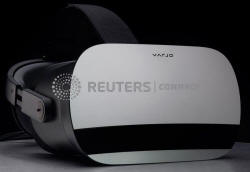|
The
most widely known VR headsets such as HTC Vive or Facebook's
Oculus have so far mostly made headlines with consumer
applications, but with a $5,995 price tag Varjo is betting on
industrial uses in architecture, engineering and construction.
"There are millions of architects or engineers working on
architectural projects ... once they start to use VR on a daily
basis, that's when we start to see the volumes," Niko Eiden,
founder and CEO of Varjo, told Reuters.
"That's when we start to see the cost go down."
Varjo has collaborated with partners including Airbus, Audi,
Saab, Volkswagen and Volvo in development of the VR-1, which was
launched in 34 countries on Tuesday.
Varjo - which has raised around $45 million from investors such
as Atomico and EQT Ventures - said its new headset has a
resolution of more than 60 pixels per degree, more than 20 times
higher than any other VR headset on the market.
"The Varjo headset is an important milestone for the VR industry
because of the incredibly high resolution that it offers. This
has the potential to offer the most realistic virtual reality to
date," said Ben Wood, head of research at UK-based tech
consultancy CCS Insight.
(Reporting by Tarmo Virki in Helsinki and George Sargent in
London; editing by David Evans)
[© 2019 Thomson Reuters. All rights
reserved.] Copyright 2019 Reuters. All rights reserved. This material may not be published,
broadcast, rewritten or redistributed.
Thompson Reuters is solely responsible for this content.

|
|





